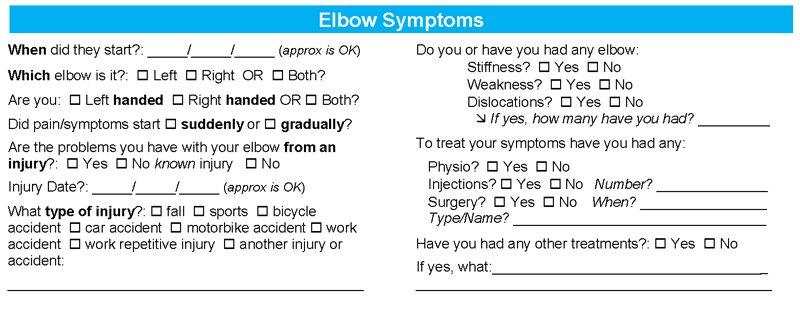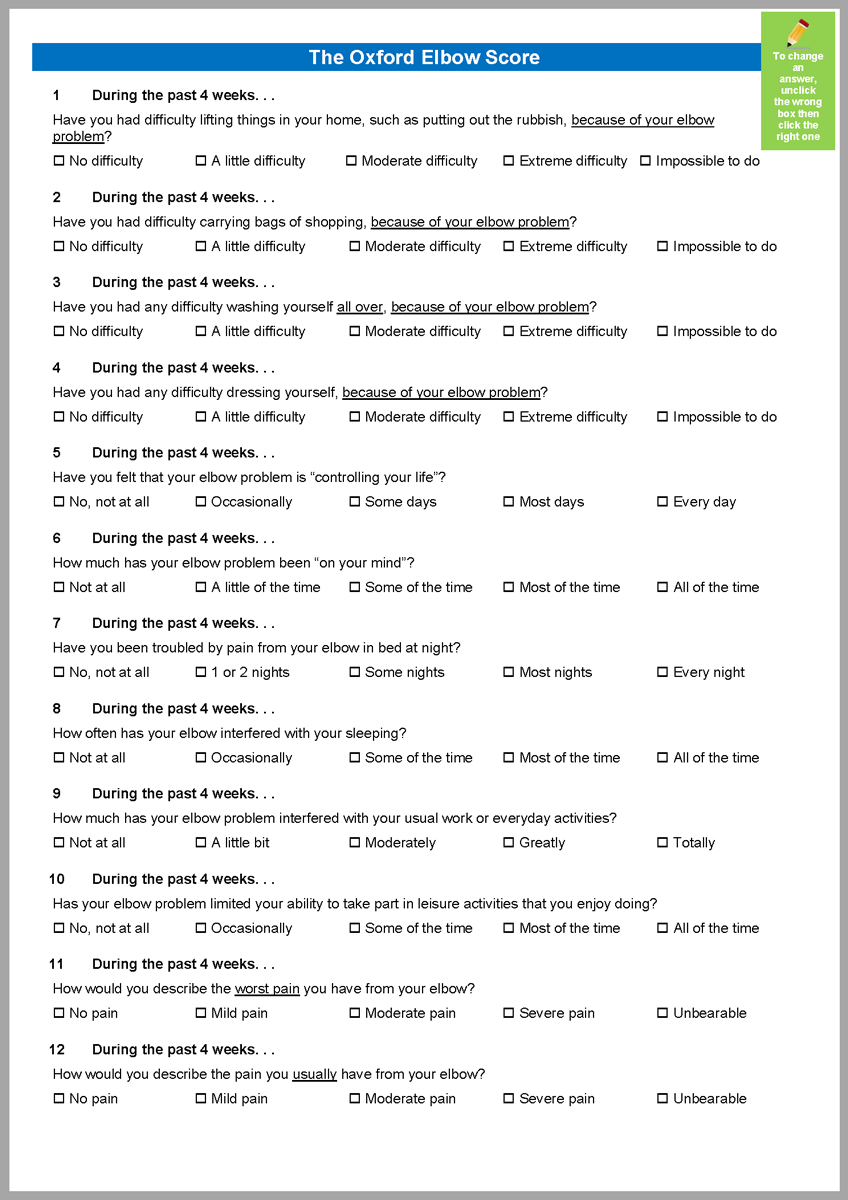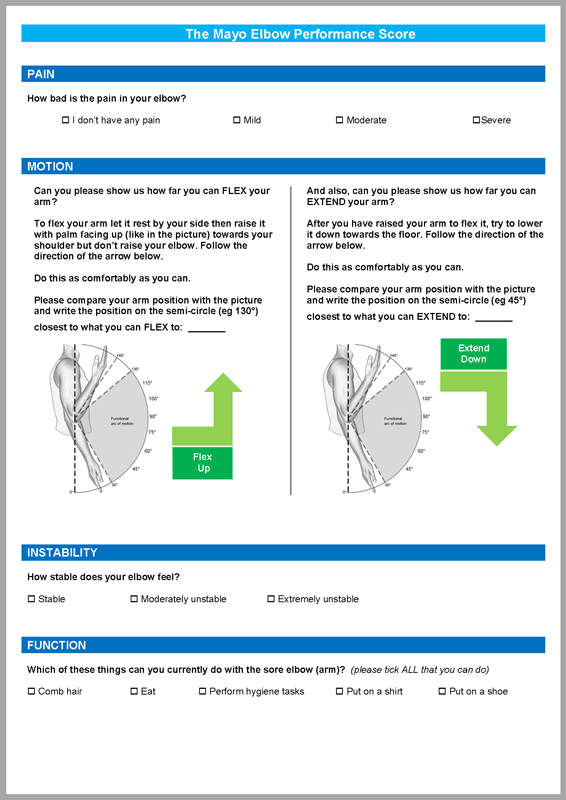
SSRI – Elbow Database
Established 2014 - Collecting information about elbow symptomsEthics
The ethics concerning establishment and maintenance of this Database was considered by the Human Research Ethics Committee of North Shore Private Hospital and approved on 21 November, 2014.
Aim
The aim of the SSRI Elbow Database is to collect information regarding elbow symptoms experienced by the general population irrespective of differentiating factors or whether surgery is required.
Of particular interest is how elbow symptoms impact daily living activities (e.g. eating, bathing and recreation), sleep, mobility, range of motion, strength and pain. Also of interest are symptom cause (if known), duration, treatments sought and whether patients concurrently experience symptoms with any other joints. Over time, the Database should be able to observe trends in elbow pathology and, hopefully, contribute positively to clinical outcomes for patients.
Method
An elbow symptoms form and 3 elbow questionnaires are completed by patients who are seeking specialist opinion for their elbow. Data is de-identified to protect patient privacy and confidentiality1, entered into the SSRI Elbow Database and then analysed using Socrates Orthopaedic Outcomes2 software.
Elbow Symptoms Form
The elbow symptoms form was designed in house for use by Sydney Shoulder Specialists surgeons and is continually updated and improved:
Elbow Survey 1
The Oxford Elbow Score3 is a patient-based questionnaire used to assess elbow symptoms. It contains a mixture of pain and function questions, derived from over 200 initial question models based on in-depth patient and clinician interviews. It has been validated against clinician-based and general health status measures.
The score is simple to complete, sensitive to clinical change, and has proven consistently reliable in determining outcomes following elbow surgery.
The total score ranges from 0 to 48 points, with higher scores indicating better function. Categorical ratings are assigned as follows: 37 to 48 points is excellent; 25 to 36 is good; 13 to 24 points is a fair outcome; and a score of less than 12 points is considered poor.
Sydney Shoulder Research Institute uses the score under licence from ISIS Innovation which is a subsidiary of the University of Oxford in England.
Elbow Survey 2
The American Shoulder & Elbow Society4 Rating Scale (Elbow) was published by the Research Committee of the American Shoulder and Elbow Surgeons. The scale contains both a patient-derived subjective assessment and physician-derived objective assessment.
For the purposes of this database, we are using only the patient-derived subjective assessment. This part of the scale consists of 2 equally weighted domains – function and pain – and has been widely utilised for assessing outcomes in patients with general elbow pathology. The total score ranges from 0 to 100 points, with higher scores indicating better function. Categorical ratings are assigned as follows: 76 to 100 points is excellent; 51 to 75 is good; 26 to 50 points is a fair outcome; and a score of less than 25 points is considered poor.
We have made 6 modifications to the scale which we believe do not affect its validity or reliability. Modifications were made after hand scoring 500 scales and observing consistent patterns of omissions, errors and corrections made by patients and confusions reported by same. Following the introduction of our modified form, omissions, errors and confusion in the next 500 scored scales significantly decreased:
- The question “do you take pain medication (aspirin, Tylenol, Advil, etc.)?” was changed to “do you take pain medication (Panadol, Nurofen, Aspirin, etc.)?” to make it more relevant to Australian patients;
- The question “how many pills do you take each day (average)?” was changed to “how many tablets do you take each day (on average) for your elbow?” as patients were noting ALL medications artificially inflating the count;
- The question “circle the number in the box that indicates….your ability to comb hair” was changed to “circle the number in the box that indicates….your ability to comb hair (or if bald/other handed do that action)” as patients were writing “I am bald” or “I am not left/right handed” then ignoring the question;
- The ranking boxes were colourized with “0” scores made red to reinforce the meaning of this score as an inability to do an action and “3” scores made green to reinforce the meaning of the score as an ability to do an action without difficulty;
- The ranking box question was changed with “Affected side” becoming “Left elbow” and “Opposite side” becoming “Right elbow” and the addition of “we need both (sides) for comparison” as patients were only completing one side or writing “left” or “right” above the side, often when they had changed their mind as to which side represented which elbow;
- The order of questions was changed with Questions 6, 9, 1, 2, 3, 4, 5, 7 and 8 presented in our version as Questions 1, 2, 3, 4, 5, 6, 7, 8 and 9, respectively as we felt this facilitated ease of and therefore encouraged completion.
You may have noticed that The American Shoulder & Elbow Society Rating Scale (Shoulder) and American Shoulder & Elbow Society Rating Scale (Elbow) are essentially the same forms with the terms “shoulder” and “elbow” interchanged.
The American Shoulder & Elbow Society Elbow Rating Scale (Shoulder) does not require a licence therefore Sydney Shoulder Research Institute and other health professionals are freely able to use it for research or clinical purposes.
Elbow Survey 3
The Mayo Elbow Performance Score5 is one of the most commonly used physician-based elbow rating systems. It consists of 4 parts: pain, motion, stability and the ability to perform five functional tasks. The total score ranges from 5 to 100 points, with higher scores indicating better function. Categorical ratings are assigned as follows: 76 to 100 hundred points is excellent; 51 to 75 is good; 26 to 50 points is a fair outcome; and a score of less than 25 points is considered poor.
We have modified the score to make it an entirely self-report form where the patient measures their own flexion and extension. The orthopaedic surgeon then confirms these measurements during consultation. Following the administration of 70 scores we have found this to be reliably accurate (0.94 with p=0.01) and therefore believe our modification does not affect the validity or reliability of the score.
Like The American Shoulder & Elbow Society Rating Scale, The Mayo Elbow Performance Score is open source i.e. a licence is not required for its use meaning Sydney Shoulder Research Institute and other health professionals can use it freely for research or clinical purposes.
To date, we have collected 70 sets of data.
Preliminary results are presented below for interest:
(NB: elbow problems are far less common than shoulder problems).
Results
SURVEYS
Oxford Elbow Score
The American Shoulder & Elbow Society Rating Scale
Mayo Elbow Performance Score
Score
29
67
70
Interpretation
Good
Good
Good
Distribution of Gender
Nearly 2/3 of people presenting with elbow symptoms were male:
Distribution of Current Age
About 1/3 of patients presenting with elbow symptoms were aged 46 – 57 years, 1/5 were aged 57 – 68 years and another 1/5 were aged 35 – 45 years:
Distribution of Cause of Injury
Nearly 1/3 of people reported having no known injury while the equal highest known causes of symptoms were sport and falls:
Duration of Symptoms
Nearly 1/2 of people reported having experienced elbow symptoms for over 12 months:
Duration of Symptoms in Years
Of those people who reported experiencing symptoms in their elbow for more than a year, 3/4 of them experienced symptoms between 2 – 19 years, 1/8 reported experiencing symptoms for between 19 – 36 years and another 1/8 for over 36 years (!):
Right or Left Handed?
The majority of people with elbow symptoms were right handed which reflects the general population:
And YET….
The difference between people who presented with elbow symptoms on their dominant side compared to their non-dominant side was not as great and in fact a slight majority presented with problems with their non-dominant elbow:
Other Joint Problems
More than 1/3 of people reported experiencing symptoms in the other elbow while symptoms in the knees and shoulders were the next highest reported:
Notes:
1The difference between the two terms is that confidentiality relates to an ethical duty, whilst privacy is a common law or statutory right, which is reflected via legislative instruments such as the Privacy Act 1988 and the National Privacy Principles (NPP).
2Learn more about Socrates Orthopaedic Outcomes Software
3Learn more about the Oxford Elbow Score
4Learn more about the American Shoulder & Elbow Society
5Learn more about the Mayo Elbow Performance Score




